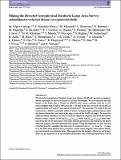Por favor, use este identificador para citar o enlazar a este item:
http://hdl.handle.net/10261/109592COMPARTIR / EXPORTAR:
 SHARE SHARE
 CORE
BASE CORE
BASE
|
|
| Visualizar otros formatos: MARC | Dublin Core | RDF | ORE | MODS | METS | DIDL | DATACITE | |

| Título: | Mining the Herschel-astrophysical terahertz large area survey: submillimetre-selected blazars in equatorial fields |
Autor: | López-Caniego, M. CSIC ORCID; González-Nuevo, J. CSIC ORCID; Massardi, Marcella; Bonavera, Laura CSIC ORCID; Herranz, D. CSIC ORCID ; Negrello, Mattia; Zotti, G. de; Carrera, Francisco J. CSIC ORCID CVN ; Danese, L.; Fleuren, S.; Hardcastle, M.; Jarvis, Matt J.; Klöckner, H. R.; Mauch, T.; Procopio, P.; Righini, S.; Sutherland, W.; Auld, R.; Baes, M.; Buttiglione, S.; Clark, C. J. R.; Cooray, A.; Dariush, A.; Dunne, L.; Dye, S.; Eales, S.; Hopwood, R.; Hoyos, C.; Ibar, E.; Ivison, R. J.; Maddox, S. J.; Valiante, E. | Palabras clave: | Quasars: general Submillimetre: general BL Lacertae objects: general |
Fecha de publicación: | 2013 | Editor: | Oxford University Press Royal Astronomical Society |
Citación: | Monthly Notices of the Royal Astronomical Society 430(3): 1566-1577 (2013) | Resumen: | The Herschel-Astrophysical Terahertz Large Area Survey (H-ATLAS) provides an unprecedented opportunity to search for blazars at sub-mm wavelengths. We cross-matched the Faint Images of the Radio Sky at Twenty-cm (FIRST) radio source catalogue with the 11 655 sources brighter than 35 mJy at 500 μm in the ∼135 deg2 of the sky covered by the H-ATLAS equatorial fields at 9h and 15h, plus half of the field at 12h. We found that 379 of the H-ATLAS sources have a FIRST counterpart within 10 arcsec, including eight catalogued blazars (plus one known blazar that was found at the edge of one of the H-ATLAS maps). To search for additional blazar candidates we have devised new diagnostic diagrams and found that known blazars occupy a region of the log(S500μm/S350μm) versus log(S500μm/S1.4 GHz) plane separated from that of sub-mm sources with radio emission powered by star formation, but shared with radio galaxies and steep-spectrum radio quasars. Using this diagnostic we have selected 12 further possible candidates that turn out to be scattered in the (r-z) versus (u-r) plane or in the Wide-Field Infrared Survey Explorer colour-colour diagram, where known blazars are concentrated in well defined strips. This suggests that the majority of them are not blazars. Based on an inspection of all the available photometric data, including unpublished VISTA Kilo-degree Infrared Galaxy survey photometry and new radio observations, we found that the spectral energy distributions (SEDs) of only one out of the 12 newly selected sources are compatible with being synchrotron dominated at least up to 500 μm, i.e. with being a blazar. Another object may consist of a faint blazar nucleus inside a bright star-forming galaxy. The possibility that some blazar hosts are endowed with active star formation is supported by our analysis of the SEDs of Planck Early Release Compact Source Catalogue blazars detected at both 545 and 857 GHz. The estimated rest-frame synchrotron peak frequencies of H-ATLAS blazars are in the range 11.5 ≤ log (νpeak, Hz) ≤ 13.7, implying that these objects are low synchrotron peak. Six of them also show evidence of an ultraviolet excess that can be attributed to emission from the accretion disc. Allowing for the possibility of misidentifications and of contamination of the 500 μm flux density by the dusty torus or by the host galaxy, we estimate that there are seven or eight pure synchrotron sources brighter than S500μm = 35 mJy over the studied area, a result that sets important constraints on blazar evolutionary models. © 2013 The Author. Published by Oxford University Press on behalf of the Royal Astronomical Society. | Versión del editor: | http://dx.doi.org/10.1093/mnras/sts680 | URI: | http://hdl.handle.net/10261/109592 | DOI: | 10.1093/mnras/sts680 | Identificadores: | doi: 10.1093/mnras/sts680 issn: 0035-8711 e-issn: 1365-2966 |
| Aparece en las colecciones: | (IFCA) Artículos |
Ficheros en este ítem:
| Fichero | Descripción | Tamaño | Formato | |
|---|---|---|---|---|
| Mining the Herschel.pdf | 1,37 MB | Adobe PDF |  Visualizar/Abrir |
CORE Recommender
SCOPUSTM
Citations
17
checked on 30-abr-2024
WEB OF SCIENCETM
Citations
16
checked on 25-feb-2024
Page view(s)
455
checked on 02-may-2024
Download(s)
264
checked on 02-may-2024
Google ScholarTM
Check
Altmetric
Altmetric
NOTA: Los ítems de Digital.CSIC están protegidos por copyright, con todos los derechos reservados, a menos que se indique lo contrario.
